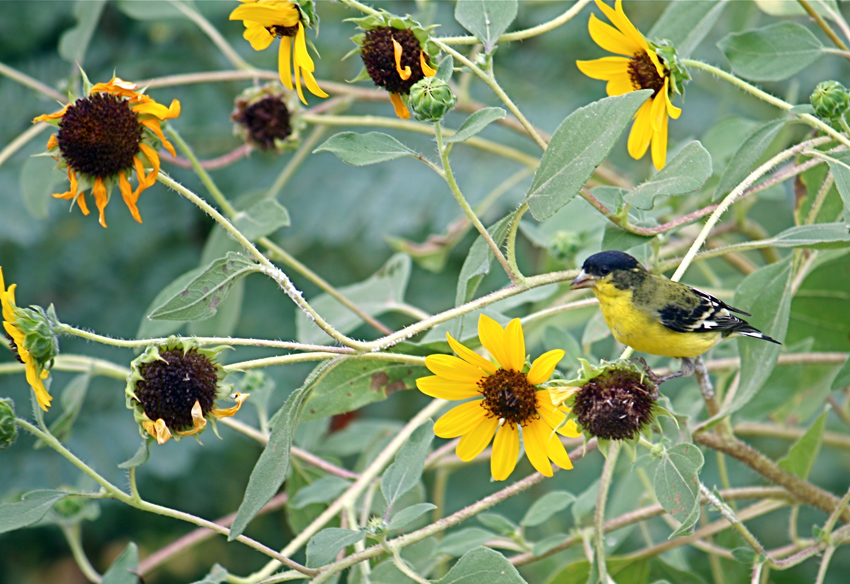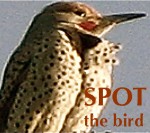Spot the bird: Lesser goldfinch fressing
We planted sunflowers in the garden for the goldfinch; it seems to have worked.
Now that the flower heads are mature and seedful on the stalks, the bushes are crowded with Lesser goldfinch.  There are lots more flowers in bloom, which will keep the hungry finches supplied into the fall or even early winter. The thin stems don’t seem to support the weight of larger birds, so the lil yellow finks have the crop to themselves. The LEGOs (LEsser GOldfinch) also love herb seeds, “Mexican Hat” (Ratibida columnaris) seeds, and the nyjer thistle we hang for them from mesh feeders. They are cling feeders, and often feed hanging head-down.
There are lots more flowers in bloom, which will keep the hungry finches supplied into the fall or even early winter. The thin stems don’t seem to support the weight of larger birds, so the lil yellow finks have the crop to themselves. The LEGOs (LEsser GOldfinch) also love herb seeds, “Mexican Hat” (Ratibida columnaris) seeds, and the nyjer thistle we hang for them from mesh feeders. They are cling feeders, and often feed hanging head-down.
Here are a couple of photos from this morning of male and female Lesser goldfinch  (Carduelis psaltria) chowing down on the seeds from the ripe sunflowers. In the top photo is an easy-to-see first-year male, nearly completely molted into his adult male plumage. The picture to the left is a “Spot the Bird” since the little bodies blend in so well, due to both color and size; I counted
(Carduelis psaltria) chowing down on the seeds from the ripe sunflowers. In the top photo is an easy-to-see first-year male, nearly completely molted into his adult male plumage. The picture to the left is a “Spot the Bird” since the little bodies blend in so well, due to both color and size; I counted  three goldfinch, two males and a less colorful, olive-y female, but there could be more. I put up a big file, so please enlarge it to see better. (All photos A.Shock)
three goldfinch, two males and a less colorful, olive-y female, but there could be more. I put up a big file, so please enlarge it to see better. (All photos A.Shock)
Lesser goldfinch are the default goldfinch of the western US. If you live east of the 100th parallel (roughly), you’ll have the dapper American goldfinch (called Carduelis tristis on account of its “sad” vocal note), who is slightly larger and yellower and who uses its noticeably pink, conical bill to open seeds. Lawrence’s goldfinch (C. lawrencei, no points for etymology there) is the most uncommon of “our” goldfinches; most of the population lives in arid California grasslands, but they roam a bit, and a few show up in Arizona and other western states most years.
Etymology
According to Choate’s American Bird Names, the genus Carduelis is derived from the Latin word carduus, thistle, goldfinches’ favorite food the world around. The species name, psaltria, is from the latin word for “lutist” because of its musical singing. They do have a bright, cheery song, lengthy for such a small bird — LEGO is the smallest of the three North American goldfinches — and they chatter delightfully in groups in the palo verde trees after the morning feeding session is finished. If you have a tough time keeping the species name “psaltria” in mind, try this mnemonic: psaltria sounds a bit like (although is totally unrelated to) “paltry”, which means small.
By the way, there is no correlation to bird body size and song duration or (relative) volume; it’s just humorous when a little beak opens up and lets out a long stream of warbly, chatty notes. The Winter wren is another small bird with a mighty song.

somehow I missed planting sunfowers this year; will put some out today in hopes of a late, warm fall. The legos really like the Rudbeckia hirta that now self-seed.
(Ratabidia is one word I adore saying, along with Raoulia)
[…] are the three goldfinches in yesterday’s Spot the Bird, highlighted in color for ease of […]
[…] is a female Lesser Goldfinch, camouflaged for nesting duties, so she’s not as jaunty as the boys, but she’ll do. (Photos […]